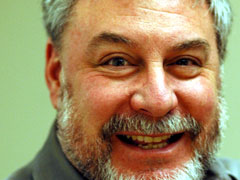Digital Detection of Breast Cancer
By Stephanie Roberts
If you think the technology to take digital pictures and rework them in Photoshop is just for family photographs, think again.
Highly promising research in breast cancer uses digital technology to detect and diagnose tumours with better accuracy than ever before. Digital mammography takes pictures of the breast that can be viewed on a screen, stored, e-mailed and tweaked to get brighter, sharper images.
“It’s very exciting,” says Dr. Martin Yaffe, a senior scientist at Sunnybrook Research Institute (SRI) and a pioneer in creating and refining breast cancer imaging methods. “It gives doctors the best chance of detecting small cancers earlier.”
Earlier detection means earlier treatment and tumour removal, and, hopefully, a longer, healthier life for women.
A powerful tool
Digital mammography (DM) works like standard mammography – the breast is compressed in a machine that takes X-ray pictures of it – with a difference. Instead of using film, radiologists use a digital detector. In the same way a digital camera works by translating what it “sees” into digital images, a DM system houses an electronic device that converts X-rays into digital images, which are manipulated at will.
“It’s like using Photoshop to adjust the picture,” says Yaffe.
Conventional mammography is an invaluable, but imperfect, screening tool. DM isn’t perfect, either, but it has powerful applications. Take delivery-on-demand. Because digital images are stored in a computer, they can be e-mailed within and between hospitals. Eventually, he says he can see doctors from remote communities consulting with radiologists at specialized centres.
Some types of DM are designed to help spot hard-to-see tumours. One application uses a contrast agent, or dye, to mark blood vessel growth signalling early tumour formation. Another, called digital tomosynthesis, assembles a series of images into three dimensions, making tumours that might otherwise be hidden viewable.
For women with signs and symptoms, radiologists generally agree that DM has diagnostic advantages over its film counterpart. As a screening tool for all women, however, the jury is out, though not for much longer. Yaffe is part of a multi-institutional study that has collected film and digital breast images from about 50,000 women. Results comparing the technologies are due early in 2005.
A team effort
DM is only one aspect of the breast cancer research at SRI. “We have this strong, interdisciplinary group of people – oncologists, radiologists, physicists, endocrinologists, epidemiologists, engineers – it’s just very exciting because there’s a lot of people interested in contributing to these problems, and by putting together our various skills, we can often do quite amazing things,” says Yaffe.
Examples include investigating how newly formed blood vessels cause tumours to grow and targeting therapies to halt that growth, refining surgical techniques, testing computer-aided detection, and using MRI and ultrasound to screen women at high genetic risk for breast cancer. Even this barebones list suggests the scope of research at SRI and whispers the promise of life-altering findings.
It’s a disease that kills, says Yaffe, of his commitment; therefore, it’s a disease to study. “We have the opportunity to do something real in medicine, and we’re doing it.”
This research is funded by the Canada Foundation for Innovation, Ontario Innovation Trust, Ontario Research and Development Challenge Fund and Terry Fox Foundation.
PDF / View full media release »





